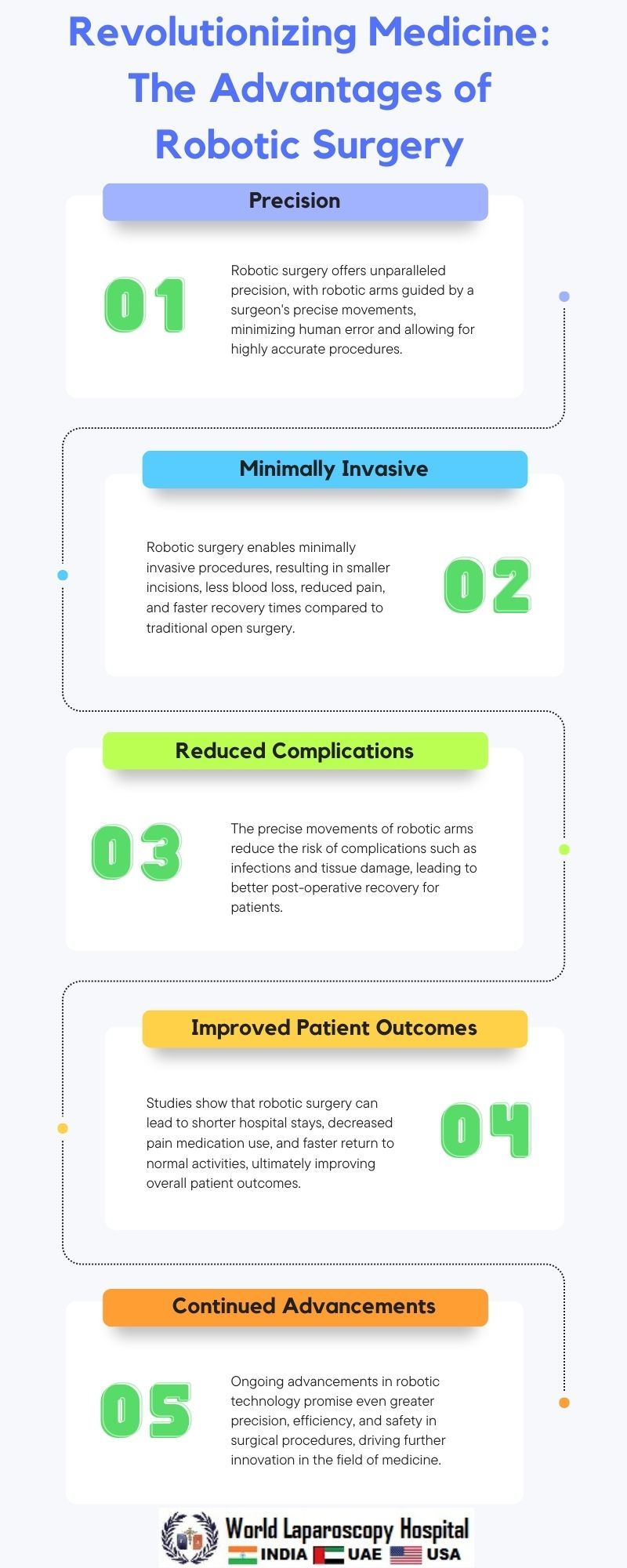Revolutionizing Medicine: The Advantages of Robotic Surgery
Introduction:
In the realm of modern medicine, technological advancements have continually reshaped the landscape of patient care. Among these innovations, robotic surgery stands out as a transformative force, revolutionizing the way surgical procedures are conducted and offering a myriad of advantages over traditional methods. This article explores the evolution of robotic surgery, its underlying technology, applications across medical specialties, and the numerous benefits it brings to both patients and healthcare providers.

The Evolution of Robotic Surgery:
Robotic surgery traces its origins to the late 20th century, with the development of early prototypes aimed at enhancing surgical precision and minimizing invasiveness. One of the pioneering systems, the da Vinci Surgical System, introduced in the early 2000s, heralded a new era in surgical techniques. This system, characterized by its robotic arms controlled by a surgeon via a console, provided unprecedented dexterity and maneuverability within the surgical field.
Over the years, robotic surgical platforms have undergone significant advancements, incorporating features such as high-definition 3D imaging, improved ergonomics, and intuitive interfaces. These enhancements have propelled the adoption of robotic surgery across a diverse range of medical specialties, including urology, gynecology, oncology, cardiothoracic surgery, and more. Today, robotic-assisted procedures have become commonplace in hospitals worldwide, revolutionizing surgical practices and expanding the scope of what is achievable in the operating room.
Understanding Robotic Surgery Technology:
At the core of robotic surgery systems lies a sophisticated blend of robotics, computer science, and medical engineering. Central to these systems are robotic arms equipped with surgical instruments, which are controlled by the surgeon from a console situated within the operating room. The console provides the surgeon with a real-time, magnified view of the surgical site through a high-definition 3D camera, allowing for precise navigation and manipulation of instruments with enhanced accuracy.
Furthermore, robotic surgery platforms employ advanced software algorithms and haptic feedback mechanisms to translate the surgeon's hand movements into precise actions performed by the robotic arms. This integration of human expertise with robotic precision enables surgeons to execute complex procedures with greater confidence and efficiency, while minimizing the risk of human error.
Applications Across Medical Specialties:
Robotic surgery has permeated nearly every medical specialty, offering a versatile toolset for a wide array of procedures. In urology, robotic-assisted prostatectomy has emerged as the gold standard for treating prostate cancer, offering improved oncologic outcomes and reduced risk of complications compared to traditional open surgery. Similarly, in gynecology, robotic hysterectomy has gained prominence for its ability to facilitate minimally invasive removal of the uterus and surrounding structures, leading to shorter hospital stays and faster recovery times for patients.
Beyond oncological and gynecological procedures, robotic surgery has found applications in cardiothoracic surgery, neurosurgery, gastrointestinal surgery, and more. In cardiothoracic procedures, such as mitral valve repair and coronary artery bypass grafting, robotic assistance enables surgeons to perform intricate maneuvers with unparalleled precision, resulting in superior patient outcomes and reduced morbidity. Additionally, in neurosurgery, robotic systems provide neurosurgeons with enhanced visualization and instrument control for delicate procedures such as tumor resections and deep brain stimulation.
The Advantages of Robotic Surgery:
The widespread adoption of robotic surgery is driven by its multitude of advantages over traditional surgical approaches. Firstly, robotic-assisted procedures offer greater precision and control, allowing surgeons to perform intricate maneuvers with submillimeter accuracy. This precision translates into improved surgical outcomes, reduced blood loss, and lower rates of postoperative complications, ultimately benefiting patient health and recovery.
Moreover, robotic surgery facilitates minimally invasive techniques, characterized by smaller incisions and reduced tissue trauma compared to open surgery. By accessing the surgical site through tiny keyhole incisions, robotic-assisted procedures minimize scarring, shorten hospital stays, and accelerate postoperative recovery, enabling patients to return to their daily activities sooner.
Furthermore, robotic surgery enhances the ergonomics of the operating room environment, reducing physical strain on surgeons and promoting better long-term occupational health. By operating from a seated position at the console, surgeons experience less fatigue and musculoskeletal discomfort during prolonged procedures, contributing to improved surgical performance and overall job satisfaction.
Additionally, robotic surgery enables surgeons to overcome anatomical limitations and perform complex procedures with greater ease. The enhanced visualization provided by 3D imaging and the articulating capabilities of robotic instruments enable surgeons to navigate tight spaces and manipulate delicate tissues with precision, even in challenging surgical scenarios.
Challenges and Future Directions:
Despite its numerous advantages, robotic surgery is not without challenges and limitations. The high cost of acquiring and maintaining robotic systems, along with the need for specialized training for surgeons and operating room staff, presents barriers to widespread adoption in some healthcare settings. Furthermore, concerns regarding the potential loss of tactile feedback and the learning curve associated with mastering robotic-assisted techniques necessitate ongoing research and training initiatives to optimize surgical outcomes and ensure patient safety.
Looking ahead, the future of robotic surgery holds promise for continued innovation and refinement of existing technologies. Advancements in artificial intelligence, machine learning, and augmented reality have the potential to further enhance the capabilities of robotic systems, enabling autonomous navigation, real-time decision support, and personalized surgical interventions tailored to each patient's unique anatomy and pathology.
Conclusion:
Robotic surgery represents a paradigm shift in modern medicine, offering unparalleled precision, versatility, and patient benefits across a spectrum of surgical specialties. By harnessing the synergy between human expertise and robotic precision, surgeons are able to push the boundaries of what is achievable in the operating room, leading to improved outcomes and enhanced quality of care for patients worldwide. As technology continues to evolve, robotic surgery holds the potential to reshape the future of surgical practice, driving innovation and advancing the frontiers of medical science.
